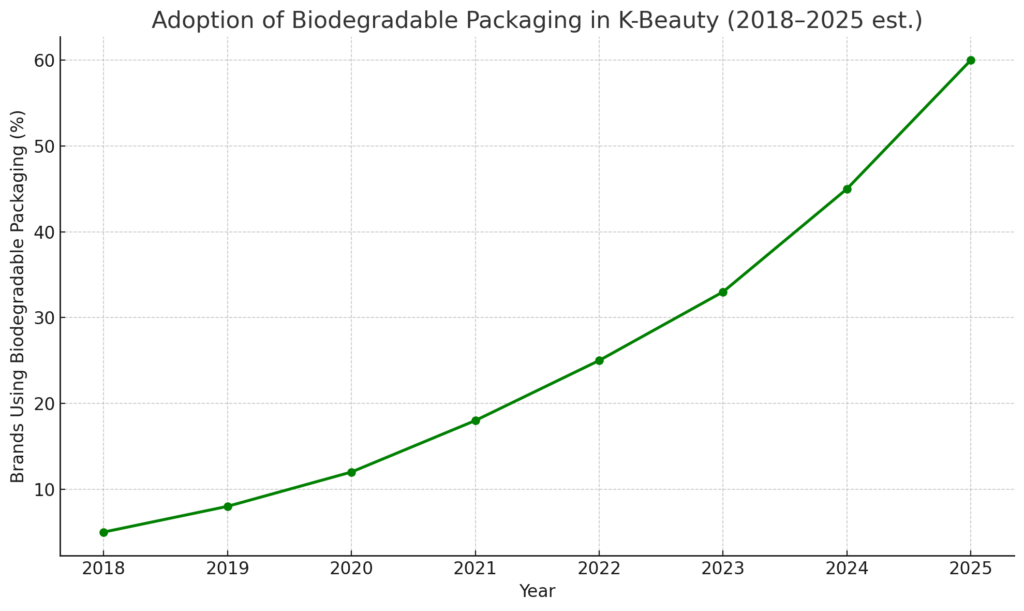From renewable energy clusters to biodegradable packaging, a green revolution is brewing in Korean cosmetics — and it’s reshaping brand strategies, global market access, and product innovation.
Korea’s beauty and cosmetics industry is entering a new era. It’s not just about innovation, unique ingredients, effective functionality, or aesthetics, but it is moving toward sustainability. With the Lee Jae-myung administration laying the groundwork for a low-carbon future, K‑Beauty brands will have to align with renewable energy mandates, ESG standards, and sustainable packaging practices. This green pivot isn’t just a policy obligation, but it will also offer a competitive advantage.
Renewable Energy Zones and Korea’s Green Infrastructure
The Korean government is setting up RE100 industrial zones which will be powered entirely by renewable energy. The development of these zones is supported by a national “Energy Superhighway” plan. These RE100 zones or hubs will supply solar, offshore wind, and green hydrogen to manufacturing centers of a multitude of businesses, including cosmetics and skincare.

But, what is RE100? It is a global collaborative initiative to bring together businesses committed to using 100% renewable energy. RE100 is a program by a non-profit organization, The Climate Group, in partnership with the Carbon Disclosure Project (CDP) group launched in 2014.
Currently, 36 Korean companies are registered as global RE100 members and use only 24% renewable energy on average. And, most of this energy transition is at overseas sites. According to the participating companies, there are structural and environmental challenges in achieving RE100 in Korea. The supply of renewable energy is insufficient and does not cover the required power consumption.
The Lee Jae-myung administration’s policy of RE100 zones will help in overcoming the current challenges that the companies face in the domestic use of renewables. The government-led initiatives such as rooftop solar in Gyeonggi industrial complexes and RE100‑style zones, companies will have better access to domestically sourced clean energy.
This creates an unprecedented opportunity for K‑beauty brands to power operations sustainably and lower their costs. Additionally, it offers a way to reduce carbon footprint and become ESG compliant for global trade and export markets.
ESG as Market Advantage & Innovation Catalyst
Beauty brands boast massive global reach; going green is no longer optional. Policy‑driven decarbonization allows companies to:
- Leverage certified clean energy for marketing and ESG ratings
- Introduce eco‑packaging, reusable systems, and recycling rewards — already proving successful with PURITO’s in‑store sustainability programs
- Tap into public procurement markets (e.g., government skincare awards, hotels, spas) thanks to green-buy mandates
Export Powerhouse: Leveraging Green Credentials in ESG-Regulated Markets
Using renewable energy in operations will also help K-beauty exporters meet the green regulatory requirements in export markets. EU’s Carbon Border Adjustment Mechanism (CBAM) and California’s biodegradable-labeling law along with California Safe Cosmetics Act are some of such state-level requirements that mandate renewable energy sourcing, eco packaging, and ingredient transparency. They are not just ethical choices but also a major positive point in a sales pitch to eco‑conscious buyers. With clean energy sourcing and other necessary green certifications, Korean beauty and cosmetics companies will be better positioned to find success in global markets.
If brands start using domestic green energy sources, they can avoid it from expensive external sources. Sustainable production will also get a boost by using government policy-backed eco‑certified industrial parks and smart grid infrastructure. Combining the two, Korean brands can position themselves as genuine in terms of quality and environmentally conscious.
Packaging Revolution: From Plastic to Purpose
Eco packaging is already gaining the momentum. With policy momentum behind circular economies, refill stations, biodegradable containers, and FSC-certified paper-based packaging are no longer niche trends. These are becoming new baselines in the K-beauty industry.
Leading K‑beauty brands like Innisfree and PURITO are pioneering eco-refill pouches, recyclable jars, and zero-waste kits. They are switching to paper from plastic, aligning with both consumer preferences and government incentives.

This chart shows a steady year-over-year rise in the use of biodegradable and refillable packaging among Korean beauty brands. The adoption of recyclable and biodegradable packaging in skincare products increased by 33% in 2023. With the market set to reach ~$900 million by 2031, it’s reasonable to project a rapid climb toward 60% biodegradability adoption by 2025, given the current momentum. This shift is accelerated by both policy incentives and export market demands.
Leading the Green Shift: Amorepacific & Startups
Amorepacific became Korea’s first major beauty company to join RE100 in 2021, committing to 100% renewable energy. And, it has reached 97% RE100 committment in its overseas sites.
Meanwhile, Korean startups are also entering the fray with solutions in:
- Waterless product formulation (reducing production emissions)
- AI-based skincare diagnostics (cutting product waste)
- Refill logistics and clean ingredient sourcing
AI: The New Beauty Lab – Beyond Gimmicks to Science-Driven Disruption
Korea’s ₩100tn AI investment targets industrial convergence, and the beauty and cosmetics industry is ground zero for R&D transformation. Using AI, companies can now qualify for 20% R&D tax credits under Korea’s “AI Industry Convergence” grants.
Amorepacific is the perfect example of how AI is saving time and effort in production. Sulwhasoo’s AI-powered mirror scans skin via spectral imaging, analyzing 5.2M microbiome data points (pH, moisture barrier, C. acnes levels). As a result, custom serums can be made in-store in just less than 8 minutes. It used to take 6 weeks after traditional R&D in labs. This level of customization and ability to cross-reference data with clinical trial results can have 89% accuracy in predicting skin reactions, which is super critical for sensitive markets like the EU.
Challenges & Opportunities
The new RE100 Industrial Zones policy by South Korean President Lee Jae-myung comes with friction. Korea’s energy grid remains insufficiently renewable domestically. Firms and NGOs need a faster infrastructure build‑out. Once functioning properly with the government’s commitment to “Energy Superhighways,” smart grids, and green public contracts, it can help in the end-to-end transformation of the industry.
This distinct change in cosmetics industry operations also requires transparency, product traceability, and green reporting, as global consumers increasingly demand verified eco‑credentials. Government support for green certification systems will be vital.
Despite strong government momentum, challenges remain:
- Korea’s domestic renewable capacity is still catching up
- Smaller brands may face upfront costs without public subsidies
- Global buyers demand verifiable green credentials, not just marketing
To address this, clearer ESG certification standards, more accessible funding for SMEs, and grid expansion for RE100 zones are critical.
Conclusion
K‑beauty’s next frontier isn’t just flawless formulations, it’s sustainability. The intersection of government policy, global demand, and tech innovation is ushering in a green renaissance for Korean cosmetics.
From energy to ethics, packaging to production, the industry is transforming — beautifully and responsibly.
If you’re looking to promote your products and connect with international buyers, please don’t hesitate to contact us.
Join us on an exciting journey to explore the vibrant world of Korean lifestyle – from the latest beauty tips to the hottest tech and so much more on Facebook, Twitter, LinkedIn, and Flipboard.









